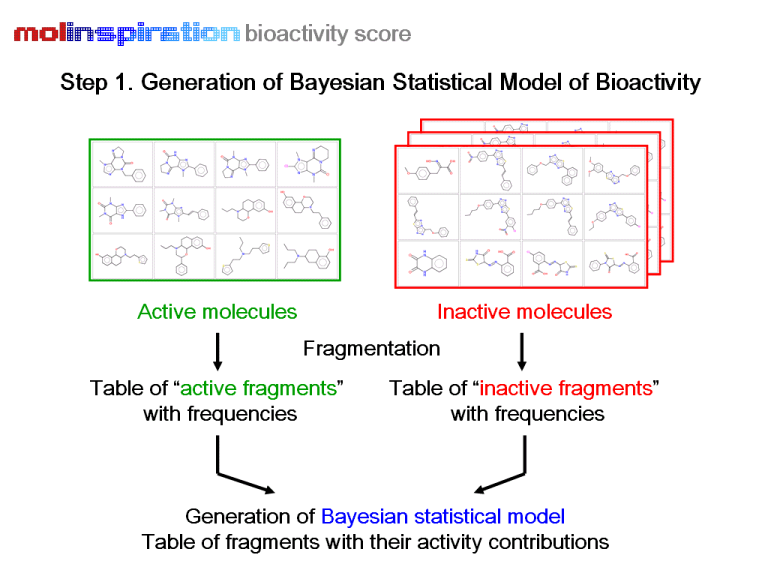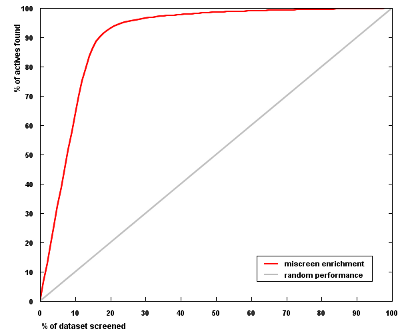
 |
| Try our interactive virtual screening service, which is powered by the miscreen toolkit (choose the option "Predict Bioactivity"). |
Virtual screening or in silico screening is the use of computational chemistry techniques to analyze large chemical databases in order to identify possible new drug candidates. Virtual screening techniques range from simple ones, based on the presence or absence of specific substructures, or match in calculated molecular properties, up to sophisticated virtual docking methods aimed at fitting putative ligand molecules into the target receptor site.
Miscreen - a Molinspiration virtual screening toolkit offers very good balance between screening speed, requirements on information needed to start a new virtual screening project and screening performance.
The miscreen toolkit first analysis a training set of active structures (in extreme case even single active molecule is sufficient to built a usable model) and compares it with inactive molecules by using sophisticated Bayesian statistics. Only SMILES or SDfile structures of active molecules are sufficient for the training, no information about the active site or binding mode is necessary. This is particularly useful in projects where structure-based approach cannot be applied because information about 3D receptor structure is not available, for example in screens aiming to find ligands modulating G-protein coupled receptors. Based on this analysis a fragment-based model is developed, where for each substructure fragment a bioactivity contribution is calculated. Once a model is build the bioactivity of screened molecules may be then calculated as a sum of activity contributions of fragments in these molecules. This provides a molecule activity score (a number, typically between -3 and 3). Molecules with the highest activity score have the highest probability to be active. Such in silico screening is very fast, large collections of molecules (more than 100'000 molecules) may be screened in an hour.
Below the schematic flow of the Molinspiration virtual screening protocol is shown.


Another advantage of our virtual screening protocol based on Bayesian statistics is, that it is able to generalize, i.e. to learn general structure requirements which are necessary for bioactivity. The identified new bioactive molecules are therefore not limited to molecules similar to the training set, but the protocol is able also to identify new active structure classes (scaffold hopping).
In the following validation test 620 diverse kinase inhibitors of 25 classas (such as CDK1, CDK2, CDK4, ALK5, p38, p53, p56, FGF, EGFr, ARK1) were used as active structures and 12'279 drug-like organic molecules as inactives. Crossvalidation set-up (50 % of data used for trainig, 50 % for testing) was used. The enrichment obtained for the test set is shown in the graph (average of 10 crossvalidation runs). Similar results have been obtained also with other activity classes including GPCR ligands, ion channel modulators, insecticides, fungicides or herbicides.

| Try our interactive virtual screening service, which is powered by the miscreen toolkit (choose the option "Predict Bioactivity"). |
If you want to get more details about the Molinspiration virtual screening package miscreen, or wish to test the toolkit at your site, contact info[at]molinspiration.com.